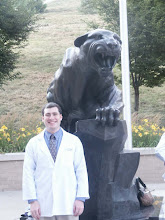I've said it before (although not in this space) and I'll say it again: medical simulation is one of the most powerful teaching techniques I've ever experienced. And it's not just good for manual skills either. Pharmacology overall has not been a poorly taught class (with one or two exceptions), but I learned more about cholinergic and anticholinergic toxicity in two hours today than in all of the lectures on the subject (some 6 or 7 hours) combined. For example, in explaining why it was a horrible idea to give a patient with myasthenia gravis either succinylcholine (it won't work) or pancuronium (the patient will be paralyzed for an extended period of time), the anesthesiologist presenting the case clarified the entire mechanism of activity of both drugs. He also included a bonus lesson in clinical management of patients so affected; while his advice may be of little help on the test, it was of immense practical value.
So why aren't we doing more to employ this particular modality? Even here at Pittsburgh, where we have a massive simulation center and the medical students make regular use of it, we're only experiencing a small fraction of its full potential. In other places, students aren't even permitted to use the mannequins; they're only used to train MDs. It seems to me that we're wasting valuable opportunities by not making the fullest possible use of this technology -- or at least spending some effort on validating it.
Anyhow, those are my thoughts for the night. Tomorrow's a study day; next entry will probably be after the test on Saturday. Till then, take care.
Peace and God bless!
Subscribe to:
Post Comments (Atom)





No comments:
Post a Comment